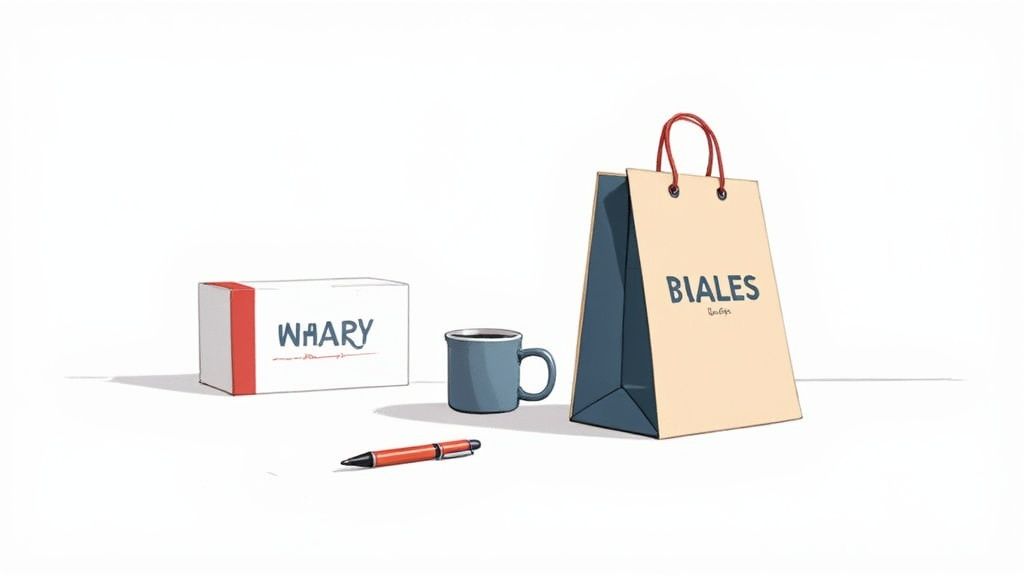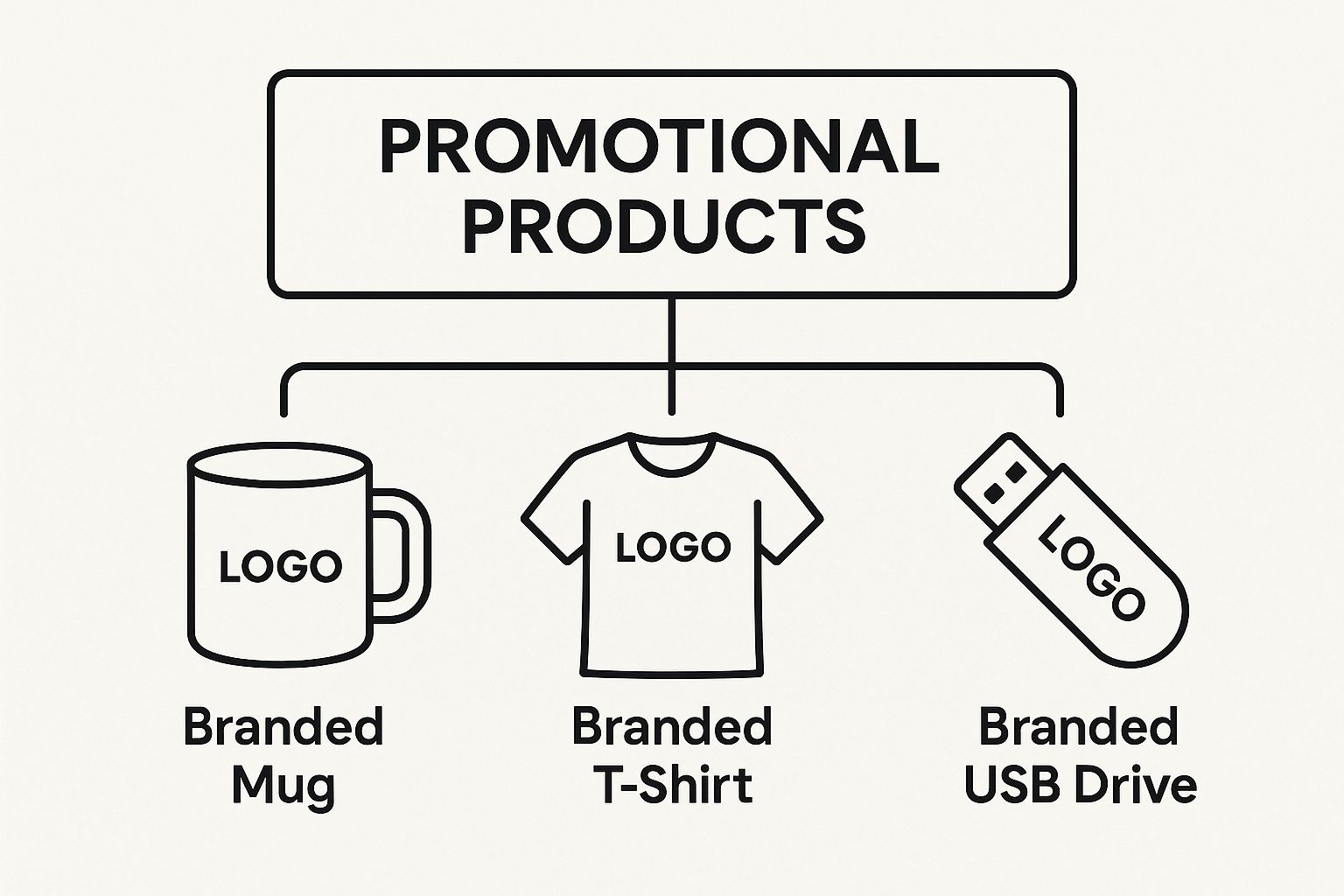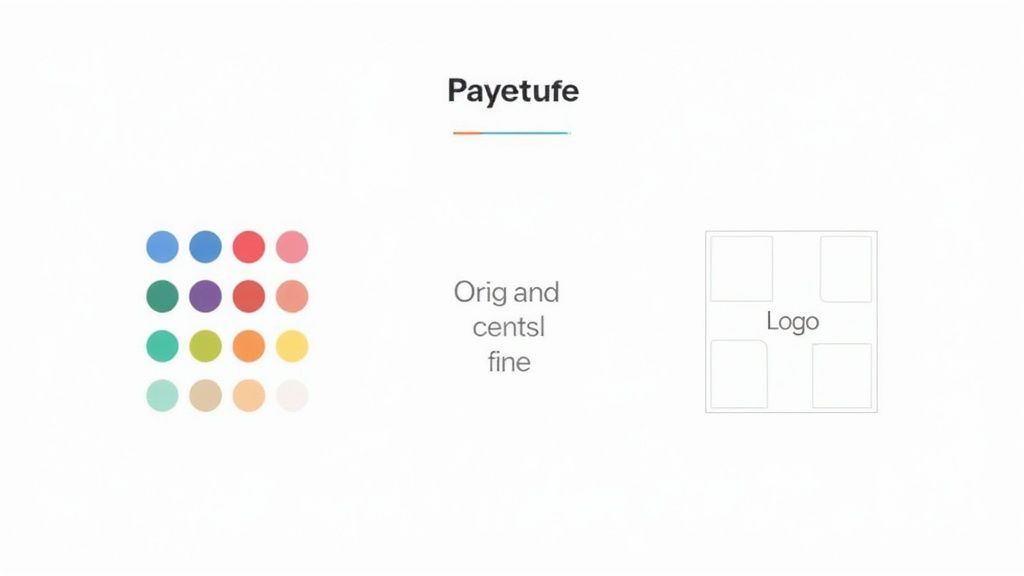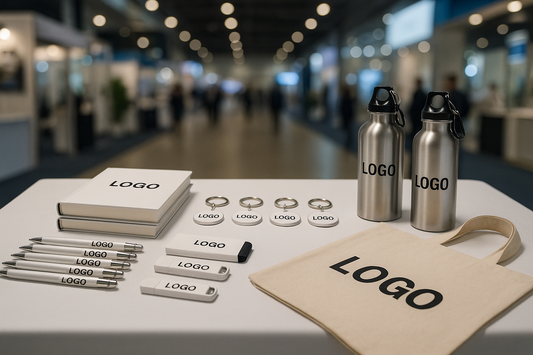
What is Promotional Merchandise? Your Ultimate Guide
Outline
-
Introduction: Beyond "Freebies"
- Hook: Differentiating promotional merchandise from cheap giveaways.
- Core Concept: Tangible, strategic marketing tools.
-
What Promotional Merchandise Really Is
- The Power of Physical Connection vs. Digital Ads.
- How it becomes part of daily life (pen, tote bag, hoodie).
- Key qualities: solving problems, brand alignment, perceived value.
-
How Branded Items Shape Brand Perception
- The psychology of receiving a useful gift (reciprocity).
- Building brand loyalty and positive impressions.
- Data points on usage and impact.
-
Choosing The Right Promotional Products
- The importance of strategic selection over random choice.
- Matching product categories to marketing goals (Awareness, Engagement, Advocacy, B2B).
- Table: Matching Products to Marketing Goals.
-
Putting Your Merchandise to Work: Strategic Scenarios
- Applying merchandise in different contexts (Trade Shows, Employee Onboarding, Customer Appreciation).
- The goal is to generate measurable results.
-
Executing a Successful Merchandise Campaign
- The importance of quality, design, and modern consumer values (sustainability).
-
FAQ: Your Promotional Merchandise Questions Answered
- Measuring ROI.
- Promotional Merchandise vs. Corporate Gifts.
- Budgeting effectively.
-
Conclusion: Your Next Steps
- Call to action: Start with one specific goal and one perfect product.
- Reinforce the message of creating value and earning a spot in the customer's world.
Let's get one thing straight: this isn't about handing out cheap "freebies." Promotional merchandise is a powerful, strategic marketing tool. We're talking about tangible items, branded with your company logo, specifically chosen to keep your business top-of-mind with customers.
Think of it like a business card that people actually use every single day.
What Is Promotional Merchandise, Really?

A digital ad might flash before someone's eyes for a few seconds and then it's gone. But a quality water bottle, a comfortable t-shirt, or a genuinely useful tech gadget? That becomes a part of someone's daily life. This creates a continuous, subtle, and positive interaction with your brand long after that initial handout.
In a world saturated with digital noise, promotional merchandise cuts right through it all by building a real, physical connection with your audience.
These items turn a simple giveaway into a lasting brand asset. Picture a branded pen sitting on a potential client's desk, a tote bag they use for their weekly grocery run, or a cozy hoodie they pull on every weekend. Each time they use it, it’s a quiet nod to your brand, building familiarity and trust without a single, aggressive sales pitch.
The core idea is to make your brand helpful, visible, and memorable. A well-chosen item doesn't just display your logo; it integrates your brand into a person's life, creating hundreds of impressions over its lifespan.
This strategy is about more than just getting your name out there; it’s about generating genuine goodwill. When you give someone a product they find truly useful, you create a positive emotional connection. This simple act of giving can profoundly influence how 8 out of 10 consumers feel about your brand.
Beyond Freebies to Brand Assets
The real secret is to stop thinking of this as "swag" and start seeing it as distributing valuable brand assets. From my experience, the promotional items that get the best results are always the ones that:
- Solve a Problem: Think of a portable power bank for a phone that's always dying or a high-quality notebook for someone who’s constantly jotting down ideas.
- Align with Your Brand: An eco-friendly water bottle for a sustainable company or a sleek tech gadget for a software firm just makes sense.
- Offer High Perceived Value: The item should feel like a thoughtful gift, not a cheap marketing throwaway.
So, when you ask "what is promotional merchandise," the answer is simple. It’s your brand, in physical form, acting as a silent ambassador. It’s your opportunity to be seen, used, and appreciated, turning people who just know about you into genuine fans of your brand.
How Branded Items Shape What People Think of Your Brand
Have you ever gotten a freebie from a company that you actually used? A sturdy tote bag, a comfortable t-shirt, or a pen that writes like a dream? If so, you’ve felt the magic of promotional merchandise firsthand. These physical items have a real psychological pull, influencing how people see, remember, and feel about your business.
Think about it. A digital ad is here one second and gone the next, fighting for a sliver of attention. But a great promotional product? That becomes a part of someone's life. It's the coffee mug they reach for every morning or the keychain they grab without thinking. This daily, positive interaction keeps your brand top-of-mind in a way that no pop-up ad ever could.
A quality promotional product does more than just show off your logo. It becomes a physical token of a good experience with your brand, quietly turning curious prospects into loyal fans.
The Real-World Impact on Customer Loyalty
Giving someone a useful gift triggers a powerful human instinct: reciprocity. When you give something of value, people feel a natural pull to give something back—in this case, their business and loyalty. This isn't just a hunch; it's a well-documented marketing principle. We’ve seen a huge shift away from cheap, disposable junk toward genuinely valuable items, and the results speak for themselves. In fact, a whopping 83% of consumers say they use the promotional products they're given. You can read more about what makes an item stick in our guide to the top promotional products to elevate your brand.
This high rate of use has a direct line to brand perception. Choosing the right item shows you get your audience and care about what they find useful. The data backs this up, with 58% of consumers confirming that receiving a promotional product gave them a more positive impression of the brand.
A single, well-made item can generate hundreds, if not thousands, of impressions over its lifespan. Suddenly, that initial investment looks incredibly smart. It’s a cost-effective way to build lasting brand equity and forge stronger relationships. At the end of the day, a thoughtful product doesn't just advertise; it connects.
Choosing The Right Promotional Products
Let’s be honest: not all swag is created equal. The difference between a branded item that gets tossed in a drawer and one that becomes a daily favorite comes down to a bit of strategic thinking. It’s not about just slapping your logo on the trendiest gadget; it’s about choosing a product that genuinely resonates with your audience and serves a clear purpose for your brand.
Think of it this way: a cheap, flimsy pen that breaks immediately is worse than giving nothing at all—it's a missed opportunity that can actually leave a negative impression. But a thoughtful, useful item? That creates a real, lasting connection. The goal is to move beyond just picking items from a catalog and start thinking about their strategic function. What are you trying to accomplish? Are you aiming for broad visibility at a trade show? Or are you looking to impress a high-value client? Each objective points toward a very different kind of product.
This simple visual breaks it down perfectly. A mug offers daily brand exposure in the office, a t-shirt turns someone into a walking advocate for your brand, and a USB drive provides genuine utility.

As the image shows, the most effective promotional campaigns often use a mix of products, each carefully selected for different audiences and goals.
Matching Products To Your Purpose
To really hit the mark, you have to think about how and where your audience will actually use the item. A great product seamlessly fits into their lives.
Here's a breakdown of how to connect different product types with specific goals:
-
Everyday Essentials: Think tote bags, notebooks, and reusable coffee cups. These are fantastic for building general brand awareness. Because they get used over and over in public, they generate a huge number of impressions at a very low cost.
-
Tech Gadgets: Items like power banks, Bluetooth speakers, or premium charging cables are perfect when you need to make a bigger splash. Reserve these for top-tier clients, employee appreciation gifts, or high-value contest prizes. Their usefulness and higher perceived value leave a strong, positive mark.
-
Wearable Apparel: T-shirts, hoodies, and hats literally turn your biggest fans into brand ambassadors. This is an incredibly powerful way to build a community and a sense of belonging, especially when the design is something people actually want to wear.
-
Desk & Office Items: Classic items like pens, mugs, and mouse pads are designed to keep your brand front-and-center during the workday. For any B2B company, this is gold. You stay top-of-mind right when business decisions are being made. When you're looking at these, it’s also smart to consider the environmental impact of promotional pens and sustainable solutions to make a more conscious choice.
To help you visualize this, here’s a quick guide to matching products with your marketing objectives.
Matching Promotional Products to Marketing Goals
| Product Category | Primary Marketing Goal | Ideal Audience | Example Products |
|---|---|---|---|
| Everyday Essentials | Widespread Brand Awareness | General Consumers, Event Attendees | Tote Bags, Water Bottles, Keychains |
| Tech & Gadgets | High-Value Engagement, Gratitude | VIP Clients, Key Partners, Employees | Power Banks, Wireless Chargers, Bluetooth Speakers |
| Apparel | Brand Advocacy & Community Building | Loyal Customers, Team Members, Fans | T-Shirts, Hoodies, Hats, Jackets |
| Desk & Office | Top-of-Mind Awareness (B2B) | Business Professionals, Office Workers | Custom Pens, Notebooks, Mouse Pads, Mugs |
This table illustrates how a little forethought can dramatically increase the impact of your promotional merchandise, ensuring you're not just giving away stuff, but making a strategic investment.
Key Takeaway: The best promotional items feel less like an advertisement and more like a genuinely thoughtful gift. When you align the product with your audience’s lifestyle and your campaign’s goals, you create a powerful marketing tool that builds authentic brand loyalty.
Putting Your Merchandise to Work
Giving away free stuff is easy. But getting real, measurable business results from it? That requires a plan.
You understand what promotional merchandise is, but the real magic happens when you pair the right item with the right moment to hit a specific goal. This is where you move from simple giveaways to smart marketing.
Think about a bustling trade show. Your goal is to cut through the noise, grab attention, and get people talking to your team. A lightweight, eye-catching item that's genuinely useful—like a well-designed tote bag or a branded multi-tool—is perfect. It acts as a magnet, drawing people to your booth and giving your sales reps a natural conversation starter.
The key is to match the product to the moment. A high-energy conference calls for a different strategy than a formal corporate dinner or an internal employee appreciation campaign.
Strategies for Different Scenarios
The context truly dictates the product. A generic pen won't make a new hire feel special, but a premium, thoughtfully curated gift set will. It sends a clear message: "We're glad you're here, and we invest in our people."
Here’s how you can put this thinking into practice:
- Employee Onboarding: Welcome new team members with a kit that makes them feel like part of the crew from day one. Think a high-quality hoodie, an engraved tumbler, and a durable notebook. It builds instant loyalty and turns them into proud brand advocates. Our guide on choosing thoughtful swag for employee gifts has even more ideas.
- Customer Appreciation: Show your most loyal clients you value their business beyond the transaction. Surprise them with something unexpected and high-end, like a premium Bluetooth speaker or a cozy branded blanket. It’s a powerful way to reinforce the relationship.
- Lead Generation: At events, use desirable items as a fair exchange for valuable information. Offer something like a portable power bank to attendees who provide qualified contact details or sit down for a product demo.
This strategic mindset is exactly why the U.S. promotional products industry is booming, with projected annual revenues now at $27.8 billion. Businesses recognize these items aren't just trinkets; they are tangible, cost-effective tools for building brand affinity. You can dig into more stats about the growth of promotional products from LogoSoftwear.com.
By aligning your merchandise with clear objectives, you can generate qualified leads, improve customer retention, and forge stronger brand loyalty.
Executing a Successful Merchandise Campaign

A great promotional merchandise campaign is about much more than just handing out free stuff. It’s a strategic effort that, when done right, delivers a real, measurable return on your investment. The first step? Figure out what you're trying to accomplish.
Are you looking to generate a wave of new leads? Boost your overall brand recognition? Or maybe you want to thank your most loyal customers for their business. Your primary goal will shape every decision you make from here on out.
Once you have a clear objective, you need to get inside the heads of your audience. What would they actually find useful or exciting? Giving a high-tech power bank to a non-technical crowd or a cheap plastic pen to a high-value client just won't land. The most effective campaigns offer genuine value by perfectly aligning the product with the recipient’s daily life.
Prioritizing Quality and Smart Design
Think of your promotional merchandise as a physical extension of your brand. A flimsy item that breaks after one use doesn't just get tossed in the bin; it can damage your reputation and leave a sour taste. It’s always worth investing in quality and usefulness to create a positive, lasting association.
Design is just as critical. Slapping your logo on an item as an afterthought rarely works.
A compelling design weaves your brand into the product naturally and tastefully. The best promotional items are things people would want to use even if they weren't branded—turning them into genuine advocates every time they use it.
This is why having a solid plan, even for something as simple as promotional pens that build brands, is so important for making sure your branding feels both effective and elegant.
Meeting Modern Consumer Values
Today’s customers care about where their products come from and what impact they have on the planet. Your merchandise strategy needs to reflect that. In fact, a study found that 46% of consumers have a more favorable opinion of a brand if the promotional item they receive is eco-friendly.
This isn't just a fleeting trend. There's been a 43% increase in searches for sustainable items in major markets, fundamentally changing the industry.
Opting for products made from recycled, biodegradable, or ethically sourced materials sends a powerful message: your brand is modern and responsible. These thoughtful choices not only polish your brand image but also ensure your merchandise makes an impact that’s genuinely positive.
FAQ: Your Promotional Merchandise Questions Answered
Alright, let's get down to the nitty-gritty. You've seen what promotional products can do, but you probably still have a few questions before you dive in. This section is designed to clear up those common sticking points and give you the confidence to move forward.
How Do I Measure the ROI of a Promotional Campaign?
Thinking about return on investment (ROI) is smart, but the "how" really depends on what you wanted to achieve in the first place. Was your goal to simply get your name out there? If so, you could track metrics like brand mentions on social media after an event or send out a quick survey to see if people remember you.
If your goal was more direct, like generating leads, the math is much simpler. Just count how many solid leads came from people who received your merch. A great industry-standard metric is Cost Per Impression (CPI). To figure this out, you just divide the total cost of your campaign by the number of times you estimate the item will be seen. It’s a fantastic way to grasp the long-term value.
What Is the Difference Between Promotional Merchandise and Corporate Gifts?
This is a great question, and the answer really boils down to two things: purpose and scale. Think of promotional merchandise as casting a wide net. You're using these items for large-scale marketing at places like trade shows or public events, aiming for maximum brand exposure to a broad audience.
Corporate gifts are the exact opposite. They are more like a focused, personal handshake. These are typically higher-quality items given to a very select group—think top clients, star employees, or crucial business partners. The goal isn't mass advertising; it's about building and strengthening key relationships.
Promotional merchandise advertises your brand to many; a corporate gift shows appreciation to a few. This distinction is key to budgeting and selection, especially when you want to boost your brand with Adelaide promotional products or in any other local market.
How Much Should I Budget for Promotional Products?
There's no magic number here. Your budget should really be a direct reflection of your goals and the kind of impression you want to make. It's often a mistake to focus only on the price tag of each item.
Instead, think about usefulness and staying power. A well-made, practical product that someone uses every day will deliver a much better return than a cheap, flimsy item that ends up in the bin by nightfall. Always remember to account for the total cost—the items, the design work, and the shipping—to avoid any surprises.
Conclusion: Start Building Your Strategy Today
You've seen what promotional merchandise can do, and now you have the tools to build a strategy that sticks.
It’s about moving beyond just another giveaway. The real magic happens when you stop thinking about "swag" and start thinking about creating genuine value. Ask yourself: what item will fit so seamlessly into my audience's daily life that they'll actually thank me for it? That’s how a simple product becomes a powerful brand ambassador.
So, where do you begin? Pick one upcoming event—a trade show, a webinar, a new product launch—and think about how a single, thoughtful item could make a real impact.
The best promotional strategies I've seen didn't start with a massive budget or a dozen different items. They started with one perfect product for one specific goal. Focus on making that first connection a memorable one.
Start sketching out your plan today. See for yourself how adding a physical touchpoint can give your marketing a whole new dimension. When you prioritize quality and genuine usefulness, you’re not just getting your logo seen; you’re earning a welcome spot in your customer's world.
That’s how you build a brand that people don't just recognize, but truly value. Start small, be strategic, and build on your successes. That next chapter for your brand? It might just start with a single, perfectly chosen product.
Article created using Outrank



